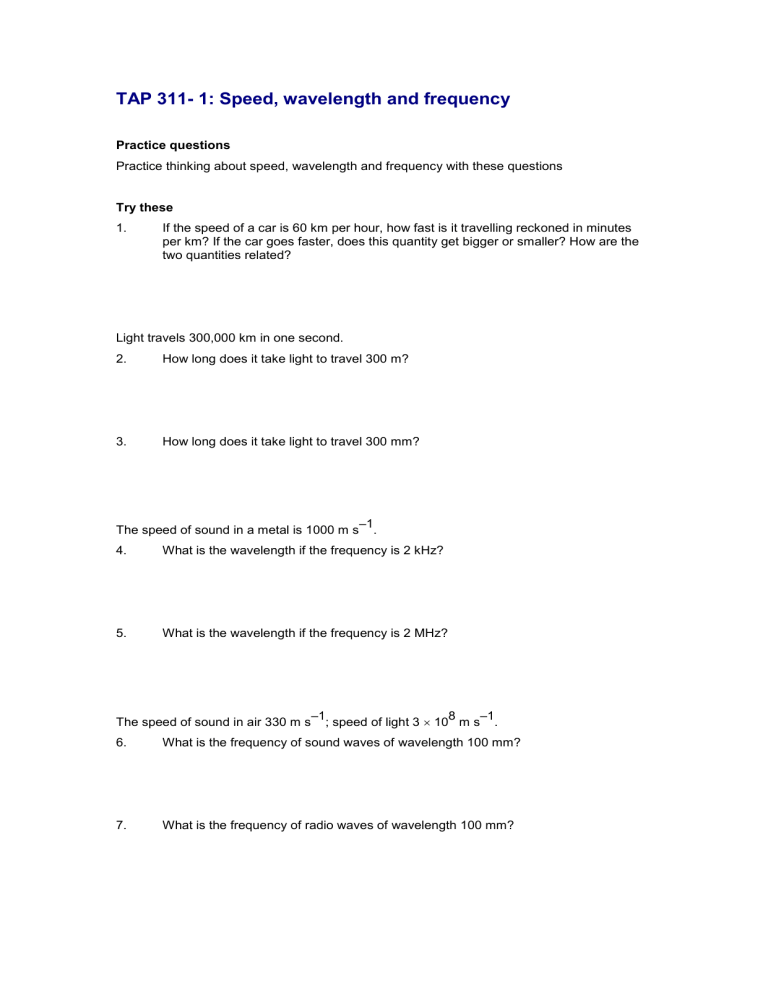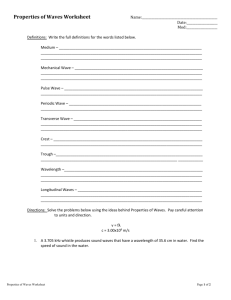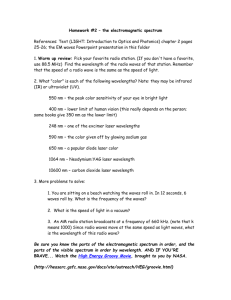TAP 311- 1: Speed, wavelength and frequency

TAP 311- 1: Speed, wavelength and frequency
Practice questions
Practice thinking about speed, wavelength and frequency with these questions
Try these
1. If the speed of a car is 60 km per hour, how fast is it travelling reckoned in minutes per km? If the car goes faster, does this quantity get bigger or smaller? How are the two quantities related?
3.
Light travels 300,000 km in one second.
2. How long does it take light to travel 300 m?
How long does it take light to travel 300 mm?
5.
The speed of sound in a metal is 1000 m s
–1
.
4. What is the wavelength if the frequency is 2 kHz?
What is the wavelength if the frequency is 2 MHz?
7.
The speed of sound in air 330 m s
–1
; speed of light 3
10
8
m s
–1
.
6. What is the frequency of sound waves of wavelength 100 mm?
What is the frequency of radio waves of wavelength 100 mm?
9.
8.
10.
If you could 'freeze' ultrasound of wavelength 5 mm as it travels through tissue, how many waves would there be in a one metre length? This quantity is called the wave number. How is it related to wavelength?
What quantity is the reciprocal of the wave frequency?
Ripple tank waves of length 2 cm travel at 15 cm s covering a glass sheet they slow down to 10 cm s
1
1
. As they pass into shallow water
. Find the original frequency of the waves. Calculate their new wavelength. Comment on the frequencies before and after the refraction.
11. If a thunder clap comes 1.5 s after the lightning strike, how far away is the strike?
Explain your calculation.
12. An echo-type depth sounder uses ultrasonic pulses. They take 25 ms to pass down, reflect from the sea floor and return to the ship. If the speed of sound in water is
1600 m s
–1
how deep is the seabed?
15.
13. FM or short-wave local radio is transmitted at 95.2 MHz. What is the radio wavelength?
14. In the MW medium wavelength band, waves are transmitted for BBC World Service at 460 m. Calculate the frequency used.
Calculate the wavelength of C#, the musical note of frequency 278 Hz.
16.
17.
Some earthquake waves have the low frequency of 0.2 Hz and a speed of 8 km s
What is their wavelength, and how long does one wave cycle take to pass?
–1
.
A bat transmits ultrasonic clicks made of sound of frequency 80 kHz; the clicks have duration of 0.1 ms. The bat increases the clicking rate from about 20 Hz to 2 kHz as it nears its prey. An echo from an unwary moth initially returns after 20 ms. Find the wavelength of the ultrasound, and the number of waves in a click. What is the initial range of the moth and why does the bat increase its click rate?
Practical advice
8.
9.
10.
2.
3.
4.
These are intended as quite simple practice questions, although they also involve using large powers of ten and scientific notation for practice. The questions involving reciprocal quantities are there for a reason: there will be many occasions in physics when reciprocal quantities will be important: for example focal length and power of a lens, conductance and resistance of a resistor.
Answer and worked solutions
1. 1 minute per km; the quantity gets smaller (fewer minutes per km); one is the reciprocal of the other.
1 microsecond
1 nanosecond
5.
6.
7.
c f
1000 m s
–1
2000 Hz
0 .
5 m
f c
1000 m s
–1
2
10
6
Hz
0 .
5 mm f
c
3 30 m s
–1
1 00
10
– 3 m
3 .
3 kHz f
c
3
10
8 m s
–1
1 00
10
– 3 m
3 GHz
200 waves per metre; the wave number is the reciprocal of the wavelength.
The time of oscillation
11.
12. f
c
1 5 cm s
–1
2 cm
7 .
5 Hz new wavelength
c f
10 cm s
7 .5
Hz
–1
1 .
3 cm frequency does not change – no waves lost or gained per second. s = v
t = 330
1.5 = 495 m, light transit time is negligible. time to the bottom = 12.5 ms
13.
14.
15.
16.
17. depth = 12.5 × 10–3 s × 1600 m s–1 = 20 m
c
f
3
10
8 m s
–1
9 5 .
2
10
6
Hz
3 .
15 m f
c
3
10
8 m s
–1
4 60 m
652 kHz
c f
3 30 m s
–1
2 78 Hz
1 .
2 m
c f
8 km s
–1
0 .2
Hz
40 km time to pass = 1/ f = 5 s
c
3 30 m s
–1
8 0
10
3
Hz
4 .
1
10
– 3 m f number of waves in a click = frequency
length of click =
80
10
3
Hz
0.1
10
–3
s = 8 waves initially distance of moth = 330 m s
–1
10
10
–3
s = 3.3 m
The bat increases the clicking rate to get more up to date information about the whereabouts of its prey; at 20 Hz it can range up to 8.25 m, at 1 kHz to 0.08 m.
Bats can resolve the Doppler shift from a moth's beating wings and hence distinguish it from a fluttering leaf.
External reference
This activity is taken from Advancing Physics chapter 1, 10S








